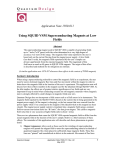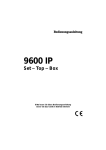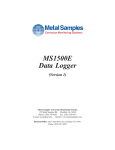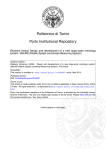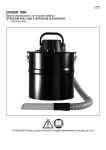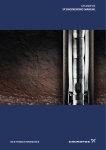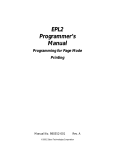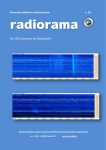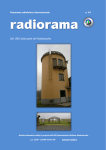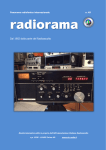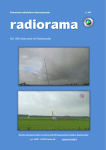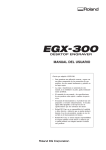Download PLEASE SCROLL DOWN FOR ARTICLE
Transcript
This article was downloaded by: [University of Bath Library] On: 27 May 2009 Access details: Access Details: [subscription number 909050074] Publisher Taylor & Francis Informa Ltd Registered in England and Wales Registered Number: 1072954 Registered office: Mortimer House, 37-41 Mortimer Street, London W1T 3JH, UK International Journal of Production Research Publication details, including instructions for authors and subscription information: http://www.informaworld.com/smpp/title~content=t713696255 Mobile Spatial coordinate Measuring System (MScMS) - introduction to the system Fiorenzo Franceschini a; Maurizio Galetto a; Domenico Maisano a; Luca Mastrogiacomo a a Politecnico di Torino, Dipartimento di Sistemi di Produzione ed Economia dell'Azienda, 10129 - Torino, Italy First Published:January2009 To cite this Article Franceschini, Fiorenzo, Galetto, Maurizio, Maisano, Domenico and Mastrogiacomo, Luca(2009)'Mobile Spatial coordinate Measuring System (MScMS) - introduction to the system',International Journal of Production Research,47:14,3867 — 3889 To link to this Article: DOI: 10.1080/00207540701881852 URL: http://dx.doi.org/10.1080/00207540701881852 PLEASE SCROLL DOWN FOR ARTICLE Full terms and conditions of use: http://www.informaworld.com/terms-and-conditions-of-access.pdf This article may be used for research, teaching and private study purposes. Any substantial or systematic reproduction, re-distribution, re-selling, loan or sub-licensing, systematic supply or distribution in any form to anyone is expressly forbidden. The publisher does not give any warranty express or implied or make any representation that the contents will be complete or accurate or up to date. The accuracy of any instructions, formulae and drug doses should be independently verified with primary sources. The publisher shall not be liable for any loss, actions, claims, proceedings, demand or costs or damages whatsoever or howsoever caused arising directly or indirectly in connection with or arising out of the use of this material. International Journal of Production Research Vol. 47, No. 14, 15 July 2009, 3867–3889 Mobile Spatial coordinate Measuring System (MScMS) – introduction to the system Fiorenzo Franceschini*, Maurizio Galetto, Domenico Maisano and Luca Mastrogiacomo Politecnico di Torino, Dipartimento di Sistemi di Produzione ed Economia dell’Azienda, Corso Duca degli Abruzzi 24, 10129 – Torino, Italy Downloaded By: [University of Bath Library] At: 13:30 27 May 2009 (Received 29 January 2007; final version received 7 December 2007) In many industrial fields (for example, automotive and aerospace) dimensional measurements of large size objects should be easily and rapidly taken. Nowadays, the problem can be handled using many metrological systems, based on different technologies (optical, mechanical, electromagnetic, etc.). Each of these systems is more or less adequate, depending on measuring conditions, a user’s experience and skill, or other factors like time, cost, dimensions, accurateness, portability, etc. In general for measuring medium-large size objects, portable systems can be preferred to fixed systems. Transferring the measuring system to the measured object place is often more practical than vice-versa. The purpose of this paper is to introduce a new system called Mobile Spatial coordinate Measuring System (MScMS). The system has been designed to perform dimensional measurements of medium-large size objects. MScMS is made up of three basic parts: a ‘constellation’ of wireless devices, liberally distributed around the working area; a mobile probe to register the coordinate points of the measured object; and a PC to store data sent by the mobile probe – via Bluetooth – and to process them by means of ad hoc application software. MScMS is easily adaptable to different measuring environments and does not require complex procedures for installation, start-up or calibration. This document presents the system hardware/software/firmware architecture and functionalities and describes the peculiarities and metrological performances of MScMS first prototype, which has been developed at the industrial metrology and quality laboratory of DISPEA – Politecnico di Torino. Finally, the most critical aspects of MScMS are illustrated and the research perspectives for future improvements are given. Keywords: mobile measuring system; wireless sensor networks; dimensional measurements; coordinate measuring machine (CMM) 1. Introduction This paper introduces a new measuring system called Mobile Spatial coordinate Measuring System (MScMS). MScMS is designed to perform simple and rapid dimensional measurements of large size objects. An essential requirement for the system is portability – that is its aptitude to be easily transferred and installed. *Corresponding author. Email: [email protected] ISSN 0020–7543 print/ISSN 1366–588X online ß 2009 Taylor & Francis DOI: 10.1080/00207540701881852 http://www.informaworld.com Downloaded By: [University of Bath Library] At: 13:30 27 May 2009 3868 F. Franceschini et al. Many types of metrological equipment, utilising different kinds of technologies (optical, mechanical, electromagnetic, etc.), give physical representations of measured objects in a three-dimensional Cartesian coordinate system. Coordinate measuring machines (CMM), theodolites/tacheometers, photogrammetry equipments, GPS (global positioning systems), laser-trackers are typical instruments to do it. Each of these systems is more or less adequate, depending on measuring conditions, a user’s experience and skill, and other factors like time, cost, size, accuracy, portability, etc. Classical CMMs that make performing of repeated and accurate measurements on objects which are even complexly shaped possible are widespread. On the other hand, CMMs are generally bulky and not always suitable for measuring large size objects (for example, longerons of railway vehicles, airplane wings, fuselages, etc.), because the working volume is limited (ISO 10360, Part 2 2001). In general, for measuring medium-large size objects, portable systems can be preferred to fixed systems. Transferring the measuring system to the measured object place is often more practical than vice-versa (Bosch 1995). Systems such as theodolites/tacheometers, photogrammetry equipment, laser-trackers, or GPS – rather than CMMs – can be easily installed and moved (Pozzi 2002). However, they can have some other drawbacks as mentioned in the next section. MScMS has been designed to be portable, easy to install and start-up, low priced and adequate for measuring medium-large size objects. Innovative measuring systems, which have been recently industrialised, only partially fulfil previous desiderata. In particular, we mention 3rd Tech Hi-Ball, Leica T-Probe and Metris Laser Radar (Welch et al. 2001, Rooks 2004). These systems – all based on optical technologies – are lightweight and very accurate, but they are relatively high priced and generally require a large time for installation and start-up. Before introducing MScMS, in the next section we provide a structured description of requirements and functionalities that a generic system should meet. At the same time, we present a taxonomy of the most common techniques and metrological equipment for dimensional measuring. Major advantages and drawbacks will be highlighted. The attention will be subsequently focused on MScMS. The following aspects will be analysed in detail: hardware and software configuration; MScMS description and description of the first prototype; trial runs and preliminary experimental results; and critical aspects and possible improvements. The final section of the document illustrates the possible improvements and research perspectives for MScMS enhancement. 2. System requirements and comparison with other measuring techniques MScMS has been designed to perform dimensional measurements of medium-large size objects – dimensions up to 30–60 metres. It should be easy to move and install, low-priced and able to work indoors (inside warehouses, workshops, laboratories). Table 1 identifies MScMS basic requirements. Considering previous requirements, we briefly analyse the most common measuring tools and techniques. Table 2 shows the result of a qualitative comparison among five measuring instruments: theodolite/tacheometer, CMM, laser-tracker, photogrammetry system, and GPS. The last row of the table takes into account MScMS target performances. Different considerations arise from Table 2. CMMs – in spite of being very accurate measuring instruments – are expensive, bulky and not easily movable. On the International Journal of Production Research 3869 Table 1. Definition and description of MScMS basic requirements. Requirement Portability Fast installation and start-up Low price Metrological performances Working volume Easy use Downloaded By: [University of Bath Library] At: 13:30 27 May 2009 Work indoor Flexibility Description Easy to move, easy to assemble/disassemble, lightweight and small sized. Before being ready to work, system installation, start-up or calibration should be fast and not too complicated. Low costs of production, installation and maintenance. Appropriate metrological performances, in terms of stability, repeatability, reproducibility and accuracy [ISO 5725 1986]. Area covered by the instrument, should be wide enough to perform measurements of large size objects (dimensions up to 30–60 metres). System should be user-friendly. An intuitive software interface should guide the user through measurements. System should be able to work indoor (inside warehouses, workshops, or laboratories). System should be able to perform different measurement typologies (i.e. determination of point coordinates, distances, curves, surfaces etc.). Table 2. Measuring systems comparison: qualitative performance evaluation. other hand, theodolites or GPS are smaller and lightweight but not very flexible, in terms of different types of measurements offered. Furthermore, GPS systems are less accurate, and cannot operate indoors. Interferometrical laser trackers and digital photogrammetry equipment are extremely accurate, but complex and expensive at the same time (Sandwith and Predmore 2001). Points to be measured need to be identified by the use of reflective markers or projected light spots. Theodolites/tacheometers are typically used in topography, but are not suitable to measure complex shaped objects. In conclusion, none of the examined measuring systems fulfil all previous requirements. MScMS is a system based on the wireless sensor network technology, able to make a trade-off among these requirements. 3870 F. Franceschini et al. 3. MScMS hardware equipment MScMS is made up of three basic parts: Downloaded By: [University of Bath Library] At: 13:30 27 May 2009 (1) A ‘constellation’ of wireless devices, distributed around the measuring area; (2) A mobile probe to register the coordinates of the object ‘touched’ points; (3) A PC to store data sent – via Bluetooth – by the mobile probe and ad hoc application software. The mobile probe is equipped with two wireless devices, identical to those making up the constellation. These devices, known as Crickets, are developed by Massachusetts Institute of Technology and Crossbow Technology. They utilise two ultrasound (US) transceivers in order to communicate and evaluate mutual distances (MIT Computer Science and Artificial Intelligence Lab 2004). The system makes it possible to calculate the position – in terms of spatial coordinates – of the object points ‘touched’ by the probe. More precisely, when a trigger mounted on the mobile probe is pulled, current coordinates of the probe tip are sent to a PC via Bluetooth. Acquired data is then available for different types of elaboration (determination of distances, curves or surfaces of measured objects). Constellation devices (Crickets) operate as reference points, or beacons, for the mobile probe. Spatial location of the constellation devices follows a semi-automatic procedure, described in Section 4.4. Constellation devices are distributed without constraint around the object to measure. In the following subsections, we describe the MScMS hardware, focusing on: . Wireless devices (Crickets); . Measuring method to evaluate mutual distances among Crickets; . Mobile probe and procedure to locate ‘touched’ points. Figure 1. Practical application of MScMS. 3871 International Journal of Production Research Downloaded By: [University of Bath Library] At: 13:30 27 May 2009 3.1 Cricket devices Cricket devices are equipped with radiofrequency (RF) and ultrasound (US) transceivers. Working frequencies are respectively 433 MHz (on RF) and 40 kHz (on US). Cricket devices are developed by Massachusetts Institute of Technology and manufactured by Crossbow Technology. Each device uses an Atmega 128L microcontroller operating at 7.4 MHz, with 8 Kb of RAM, 128 Kb of FLASH ROM (program memory), and 4 Kb of EEPROM (mostly as read-only memory). Alimentation is provided by two ‘AA’ batteries of 1.5 V (Balakrishnan et al. 2003). Cricket devices are quite small (see Figure 2) easy to move, and cheap (each unit would cost about 10–20 E, if mass-produced). Due to these characteristics, they are optimal for ad hoc wireless sensor network applications (Priyantha et al. 2000). Crickets are equipped with US transceivers (quartz crystals) which transform electric energy into acoustic, and vice-versa (piezo-electric effect). They generate/receive 40 kHz ultrasound waves. Transducers excited by electric impulses, vibrate at the resonance frequency producing acoustic ultrasound impulses (ANSI/IEEE Std. 176-1987 1988). 3.2 Evaluation of distances between Cricket devices Cricket devices continuously communicate with each other in order to evaluate mutual distances. Device communication range is typically 8–10 metres, in the absence of interposed obstacles. The technique implemented by each pair of Crickets to estimate mutual distance is known as time difference of arrival (TDoA). It is based on the comparison between the propagation time of two signals with different speed (RF and US in this case) (Savvides et al. 2001). TDoA technique is described as follows: (1) At random time intervals, included between 150 and 350 milliseconds, each device transmits an RF query-packet to other devices within its communication range. It checks if neighbouring Crickets are ready to receive a US signal (Figure 3(a)) (Priyantha et al. 2000). (2) Ready devices reply sending an RF acknowledgement authorising next signal transmission (Figure 3(b)). Ultrasound receiver (c) a Integrated antenna for RF transceiving ≈1.2 cm ≈9 cm b c (a) Ultrasound transmitter ≈4 cm Photo Perspective view Figure 2. Cricket device (Crossbow Technology). Orthogonal projection (b) Downloaded By: [University of Bath Library] At: 13:30 27 May 2009 3872 F. Franceschini et al. Figure 3. Communication scheme implemented by Cricket devices (Priyantha et al. 2000). device 1 device 2 RF (c - speed of electromagnetic radiation) query (RF signal) concurrent transmission of RF and US signals RF RF authorisation for next transmission RF US (s - speed of sound) Δt (TDoA) time lapse between reception of RF and US signals t d t Figure 4. Time evolution of RF and US signals: qualitative scheme. (3) Querying Cricket is now authorised to concurrently send an RF and a US signal (Figure 3(c)). (4) Receiving device measures the lapse time between reception of RF and US signals (see Figure 4). The distance between two devices is calculated by the following formula: d¼ t , ð1=SÞ ð1=CÞ ð1Þ where c is the speed of electromagnetic radiations, s the speed of sound, and t is TDoA (Gustafsson and Gunnarsson 2003). Since there is a large difference 3873 International Journal of Production Research D B2, B4 D B4, B5 D B5, B6 B2 D B1, B2 B4 D B2, B3 D B4, B9 D B3, B4 D B1, B3 D B4, B8 B3 B1 B6 B5 D B5, B9 D B6, B9 D B3, B8 D B2, B7 D B5, B8 D B3, B7 D B1, B7 D B8, B9 B9 D B7, B8 B8 Downloaded By: [University of Bath Library] At: 13:30 27 May 2009 B7 + B8 communication range Distances received by device B8 Distances discardedby B8 Distances stored by B8 (and sent to its neighbours) Figure 5. Distance information handled by a single device (B8). The shadow highlights the B8 communication range. between c (about 300,000 km/s) and s (about 340 m/s in air with temperature T ¼ 20 C and relative humidity RH ¼ 50%) then: d s t ð2Þ 3.3 Cricket communication Cricket devices build a wireless network of cooperating sensor nodes. To preserve network scalability, that is to make sure that the amount of information stored by each node is independent from network dimension (in terms of nodes), each node memorises the distances from its direct neighbours contained in the communication range (see Figure 5). 3.4 The mobile probe The mobile probe is equipped with two Cricket devices aligned with the tip (see Figure 6). The system has been designed to be deployed over small or wide areas, depending on the dimension of measured objects. The measuring area can be ‘covered’ varying the number of constellation nodes. 4. MScMS software architecture This section describes software/firmware features of MScMS to implement the following operations: . Location of Crickets mounted on the mobile probe; . Location of points touched by the probe; 3874 F. Franceschini et al. Perspective view Orthogonal view B V A A B V G C Downloaded By: [University of Bath Library] At: 13:30 27 May 2009 A, B C V AB,BV G Cricket devices Bluetooth adapter to PC Probe tip (touching measured object) Fixed distances Trigger C Figure 6. Schematic representation of the mobile probe. (x4, y4, z4) (x2, y2, z2) (x3, y3, z3) Distances from device B Distances from device A (V) point touched by the probe (x1, y1, z1) (x5, y5, z5) V measured object B (xB, yB, zB) Operation 2 (xV, yV, zV) PC A Z (xA, yA, zA) Operation 1 Y X Figure 7. Location of points touched by the probe. . Communication and data sharing among Cricket devices; . Semi-automatic location of constellation devices. Figure 7 represents the first two operations. All operations are better described in the following subsections. 4.1 Location of Crickets mounted on the mobile probe Spatial location of each Cricket probe is performed using a trilateration technique. Trilateration uses the known locations of beacon reference points. To uniquely determine 3875 International Journal of Production Research C2 (x2, y2, z2) C4 (x4, y4, z4) M2 C6 (x6, y6, z6) M6 C8 (x8, y8, z8) M4 C3 (x3, y3, z3) M3 C5 (x5, y5, z5) M5 C7 (x7, y7, z7) P (u, v, w) M1 Z Y C1 (x1, y1, z1) X Distances utilized for the location of a device P Downloaded By: [University of Bath Library] At: 13:30 27 May 2009 P communication range C1÷C6 Devices within device P communication range Figure 8. Location of a generic device P. the relative location of a point on a 3D space, at least four reference points are generally needed (Sandwith and Predmore 2001, Chen et al. 2003, Akcan et al. 2006). In general, a trilateration problem can be formulated as follows. Given a set of nodes ni with known coordinates (xi, yi, zi) and a set of measured distances Mi, a system of nonlinear equations needs to be solved to calculate the unknown position of a generic point P (u, v, w) (see Figure 8). 2 3 ðx1 uÞ2 þ ðy1 vÞ2 þ ðz1 wÞ2 6 ðx uÞ2 þ ðy vÞ2 þ ðz wÞ2 2 2 6 2 6 6 4 ðxn uÞ2 þ ðyn vÞ2 þ ðzn wÞ2 .. . 2 M21 3 7 6 M2 7 7 6 27 7¼6 7 7 6 .. 7: 5 4 . 5 ð3Þ M2n If the trilateration problem is over defined (four or more reference points), it can be solved using a least-mean squares approach (Savvides et al. 2001). Each unknown node (generically P) estimates its position by performing the iterative minimisation of an error function (EF), defined as: Xn ½Mi Gi 2 i¼1 EF ¼ , ð4Þ n where: Mi measured distance between the i-th node and the unknown device (P); Gi calculated distance between the estimated position of P (u, v, w) and the known position of the i-th device Ci (xi, yi, zi); n number of constellation devices (Ci, i ¼ 1, . . . , n) within device (P) communication range. Each Cricket mounted on the mobile probe to locate its own position uses the known locations of at least four constellation Crickets, and the measured distance from them. All information needed for the location is sent to a PC, for centralised computing. 3876 F. Franceschini et al. 4.2 Location of points touched by the probe tip The probe tip (V) lies on the same line of devices A and B (see Figure 6). This line can be univocally determined knowing coordinates of points A (xA, yA, zA) and B (xB, yB, zB), and the distance d(A V). The parametric equation of this line is: 8 x ¼ xA þ ðxB xA Þ t > > < y ¼ yA þ ðyB yA Þ t : ð5Þ > > : z ¼ zA þ ðzB zA Þ t Downloaded By: [University of Bath Library] At: 13:30 27 May 2009 The distance d(A V) can be expressed as: qffiffiffiffiffiffiffiffiffiffiffiffiffiffiffiffiffiffiffiffiffiffiffiffiffiffiffiffiffiffiffiffiffiffiffiffiffiffiffiffiffiffiffiffiffiffiffiffiffiffiffiffiffiffiffiffiffiffiffiffiffiffiffiffiffiffiffiffiffiffiffiffiffiffiffiffi dðA VÞ ¼ ðxA xV Þ2 þ ðyA yV Þ2 þ ðzA zV Þ2 : ð6Þ Coordinates of point V (xv, yv, zv) are univocally determined solving a system of four equations in four unknown values (xv, yv, zv, and tv): 8 xV ¼ xA þ ðxB xA Þ tV > > > > < yV ¼ yA þ ðyB yA Þ tV : ð7Þ zV ¼ zA þ ðzB zA Þ tV > > q ffiffiffiffiffiffiffiffiffiffiffiffiffiffiffiffiffiffiffiffiffiffiffiffiffiffiffiffiffiffiffiffiffiffiffiffiffiffiffiffiffiffiffiffiffiffiffiffiffiffiffiffiffiffiffiffiffiffiffiffiffiffiffiffiffiffiffiffiffiffiffiffiffiffiffi ffi > > : dðA VÞ ¼ ðxA xV Þ2 þ ðyA yV Þ2 þ ðzA zV Þ2 Replacing terms xv, yv and zv in the fourth equation: vffiffiffiffiffiffiffiffiffiffiffiffiffiffiffiffiffiffiffiffiffiffiffiffiffiffiffiffiffiffiffiffiffiffiffiffiffiffiffiffiffiffiffiffiffiffiffiffiffiffiffiffiffiffiffiffiffiffiffiffiffiffi u u ½xA ðxA þ ðxB xA Þ tV Þ2 u 2 dðA VÞ ¼ u t þ½yA ðyA þ ðyB yA Þ tV Þ : ð8Þ þ½zA ðzA þ ðzB zA Þ tV Þ2 then: dðA VÞ dðA VÞ : tV ¼ qffiffiffiffiffiffiffiffiffiffiffiffiffiffiffiffiffiffiffiffiffiffiffiffiffiffiffiffiffiffiffiffiffiffiffiffiffiffiffiffiffiffiffiffiffiffiffiffiffiffiffiffiffiffiffiffiffiffiffiffiffiffiffiffiffiffiffiffiffiffiffiffiffiffiffi ¼ dðA BÞ 2 2 2 ðxA xB Þ þ ðyA yB Þ þ ðzA zB Þ ð9Þ The denominator of Equation (9) is the distance d(A B) between the two Cricket devices installed on the mobile probe. In conclusion, coordinates of the point V can be calculated as: 8 dðA VÞ > > xV ¼ xA þ ðxB xA Þ > > > dðA BÞ > > < dðA VÞ : ð10Þ yV ¼ yA þ ðyB yA Þ > dðA BÞ > > > > dðA VÞ > > : zV ¼ zA þ ðzB zA Þ dðA BÞ Formulas (10) univocally locate point V using spatial coordinates of Crickets A and B. Distances d(A B) and d(A V) are a priori known as they depend on probe geometry. The previous model is based on the assumption that US sensor (A and B) and probe tip (V) are punctiform geometric elements. In practice, the model is inevitably approximated International Journal of Production Research 3877 because sensors A and B have non punctual dimensions (see Figure 2). To minimise point P position uncertainty, the following condition should be approached: d(B V) d(A V) (Zakrzewski 2003). Downloaded By: [University of Bath Library] At: 13:30 27 May 2009 4.3 Cricket firmware Firmware is essential to organise RF and US communication among Cricket devices. Firmware is written in NesC language, and works under the operating system TinyOS. NesC is derived from C, and it is currently utilised to program MICA Mote devices (produced by Crossbow Technologies), which Crickets are derived from. NesC is object-oriented and event-based. Programs are organised in independent modules. They interrelate themselves by means of reciprocal queries/replies (MIT Computer Science and Artificial Intelligence Lab 2004, Moore et al. 2004). Figure 9 shows a schematic flow-chart of Cricket firmware. Each Cricket device performs two types of operation: (1) Time of flight measurement of US signals transmitted/received from other devices. At random time intervals, included between 150 and 350 milliseconds, each device tries to synchronise itself with neighbours, in order to exchange US signals. Synchronisation information is transmitted through RF packets. (2) When a Cricket receives a new distance – from a neighbour, or directly measured – stores and sends it to its neighbours by an RF packet containing a new list of inter-node distances. Firmware coordinates the communication among Cricket devices, making them able to cooperate and share information about inter-node distances. When the user pulls the mobile probe trigger, all information is sent (via Bluetooth) to a PC for elaboration. 4.4 Semi-automatic location of the constellation Location of Cricket devices should be fast and automated as much as possible. This operation – if manually performed – is tedious and conflicting with system adaptability to different working places. As a consequence – in order to minimise human moderation – a method for a semi-automatic localisation has been implemented. It is important to remark that accuracy in the localisation of constellation nodes is fundamental for accuracy in the next mobile probe location (Patwari et al. 2005, Sottile and Spirito 2006). Two techniques for the location of constellation devices have been designed. 4.4.1 First approach First technique consists of touching (using the mobile probe) different reference points within the measuring area. It is good to select points that are easily reachable and easy to be manually located in a reference coordinate system. For example, points lying on objects with a simple and known geometry (like parallelepiped vertexes). Spatial coordinates (xi, yi, zi) of the distributed constellation devices are the unknown parameters of the problem. Location of each device is performed using a trilateration. To identify a new request of US transmission (via RF) and waiting handshaking (RF) event: receipt (via RF) of authorisation about US transmission RF channel handling (RF) request of authorisation for US transmission event: time-out for a new request of US transmission Figure 9. A schematic flow-chart of the Cricket firmware. updating, and data forwarding towards neighbours (via RF) data elaboration event: RF data receipt (new distances) US channel handling trasmission of US signal event: receipt of the goahead for US transmission measured data transmission to PC (via Bluetooth) event: probe trigger pull sub-modules for communication main modules events for the modules activation updating, and data forwarding towards neighbours (via RF) new distance measure reception event: US signal Downloaded By: [University of Bath Library] At: 13:30 27 May 2009 3878 F. Franceschini et al. 3879 International Journal of Production Research D D B4 B3 B5 B1 PC B2 α B A B A P2 (x2, y2, z2) Downloaded By: [University of Bath Library] At: 13:30 27 May 2009 P1 (x1, y1, z1) P3 (x3, y3, z3) P4 (x4, y4, z4) (a) P2 (b) Figure 10. Location of constellation device B4, utilising distances from P1, P2, P3, P4 reference points. device it is necessary to know distances from at least four reference points (Chen et al. 2003). Figure 10(a) represents the procedure to determine distances from some reference points and a constellation Cricket. The probe tip is placed next to the point P2, with the aim of calculating the distance from Cricket B4 (point D). The following distances are known: . AD and BD: from constellation Cricket B4 and devices A and B; . AB and P2B: from devices A and B – mounted on the mobile probe – and from the device B and the probe tip (P2). To calculate distance P2D, we can use the Carnot Theorem (see Figure 10(b)). Applying this theorem to triangle ABD, we obtain the following equation: AD2 ¼ AB2 þ BD2 2 AB BD cosðÞ: ð11Þ From which: cosðÞ ¼ AB2 þ BD2 AD2 : 2 AB BD ð12Þ Applying again Carnot theorem to triangle P2BD: P2 D2 ¼ P2 B2 þ BD2 2 P2 B BD cosðÞ: Substituting Equation (12) within Equation (13) we obtain: sffiffiffiffiffiffiffiffiffiffiffiffiffiffiffiffiffiffiffiffiffiffiffiffiffiffiffiffiffiffiffiffiffiffiffiffiffiffiffiffiffiffiffiffiffiffiffiffiffiffiffiffiffiffiffiffiffiffiffiffiffiffiffiffiffiffiffiffiffiffiffiffiffiffiffiffiffiffiffiffiffiffi AB2 þ BD2 AD2 P2 D ¼ P2 B2 þ BD2 P2 B AB ð13Þ ð14Þ Equation (14) makes it possible to calculate the distance from the reference point P2 to the constellation device B4 (point D). The described procedure is repeated for all reference points (i.e. P1 – P4 in Figure 10). Once all required distances have been taken, a trilateration technique can be applied in 3880 F. Franceschini et al. D B4, B5 B4 D B1, B4 D B2, B4 D B3, B4 D B3, B5 B5 D B1, B3 B1 D B1, B2 D B2, B3 B3 PC B2 Downloaded By: [University of Bath Library] At: 13:30 27 May 2009 A B1÷B5 constellation Crickets A, B probe Crickets B Distances utilised in these mi-automatic location of the constellation D B1, B2 D B1, B3 D B1, B4 D B2, B3 D B2, B4 D B3, B4 D B3, B5 D B4, B5 Figure 11. Constellation location using the mobile probe as an ‘ear’. order to localise each constellation Cricket. The acquisition procedure is driven by an ad hoc software routine. Calculations are automatically performed by the central PC. 4.4.2 Second approach The second approach is an extension of the first. The previous localisation approach is not adequate for constellations with a large number of Crickets, since each device needs to know distances from at least four reference points. For that reason, we have implemented a semi-automatic localisation technique, which also uses the information on the mutual distances among constellation Crickets. This technique is based on two steps: (1) As described for the first approach, the mobile probe is used to touch four reference points in order to locate five constellation Crickets. (2) Subsequently, the mobile probe is used as an ‘ear’, to receive the mutual distances of all the constellation Crickets (including the five which have been located). Signals gathered are sent to the PC (see Figure 11). This information – combined with the information on the five located Crickets – is used to locate the whole constellation, by means of an ‘incremental’ algorithm (Moore et al. 2004). This algorithm starts with a set of five nodes with known coordinates. Other nodes in the network determine their own coordinates using distances from them. As an unknown node obtains an acceptable position estimate, it may serve as a new reference point. This process can be incrementally applied until all nodes in the network obtain their specific coordinates. The procedure is driven by an ad hoc software routine. Time required for self-localisation is about 1–2 minutes. Calculations are automatically performed by the central PC. International Journal of Production Research 3881 Figure 12. Mobile probe prototype. Downloaded By: [University of Bath Library] At: 13:30 27 May 2009 Again, accuracy in constellation location influences accuracy in future measurements. The more Cricket positions are affected by uncertainty, the less accurate measurements will be (Taylor et al. 2005, Franceschini et al. 2007). 5. MScMS prototype A first prototype of MScMS has been developed at the industrial metrology and quality laboratory of DISPEA – Politecnico di Torino. It is made by the following elements: (1) Cricket constellation. Twenty-two Cricket devices have been freely distributed around a measuring area, covering a volume of about 60 m3. To make their positioning easy, we used different supports, such as booms, articulated arms and tripods (see Figure 1). (2) Mobile probe. It is made by a metal structure containing the following elements: (a) Two Cricket devices. (b) A tip to ‘touch’ the points of measured objects. Tip (V) and Cricket devices (A and B) are aligned and spaced as indicated: d(A B) ¼ 450 mm and d(A V) ¼ 540 mm (see Figure 12). (c) A bluetooth transceiver connected with one of the two Cricket devices, by an RS232 serial port. (3) Personal computer. Ad hoc application sofware runs on a standard PC. In order to receive data sent by the probe, the PC is equipped with a bluetooth transceiver. (4) Application software. The purpose of this software is to drive the user through measurements, and to make results display efficient. Functions provided are similar to those typically implemented by CMM software packages. MScMS, likewise CMMs, make it possible to determine the shape/geometry of objects (circumferences, cylinders, planes, cones, spheres, etc.), on the basis of a set of measured surface points gathered from the mobile probe, using classical optimisation algorithms (Overmars 1997). In more detail, the software is organised into three application modules to assist the user in the following operations: . Initialisation. This is a guided procedure to switch on wireless devices (Crickets and bluetooth adapter), and open the PC connection for data reception from the mobile probe. Downloaded By: [University of Bath Library] At: 13:30 27 May 2009 3882 F. Franceschini et al. Figure 13. MScMS software menu. . Self-localisation of the constellation. This procedure is described in Section 4.4 (Figure 13(a)). . Measurements. Execution of different kinds of measurements: single points measurements, distance measurements, curves and surfaces evaluation (see Figures 13(b), 14 and 15). Measurements are taken by the probe tip. When the probe trigger is pulled, the application software calculates Cartesian coordinates of the touched point. If measurement is correctly taken, an acoustic signal is emitted. Measured results are displayed using numeric and graphical representations. Figure 13 shows some screenshots of the software main menu and sub-menus. Figures 14 and 15 show some displays of the MScMS software. 6. MScMS actual performances, critical aspects and possible improvements A preliminary prototype of MScMS has been set-up and tested, with the purpose of verifying system feasibility and to evaluate the performances. The prototype actual performance has been estimated carrying out two practical tests: (1) Repeatability test: a single point within the working volume is measured repeating the measurement about 50 times, leaving the mobile probe in a fixed position (see Figure 16(a)). The test is repeated measuring at least 20 different points in different areas of the working volume. For each point, we have calculated the standard deviations ( x, y, z) related to the registered Cartesian coordinates (x, y, z). (2) Reproducibility test: this test is similar to the previous one, with the only difference that the mobile probe orientation is changed before each measurement, with the aim of approaching each (single) point from a different direction (see Figure 16(b)). Downloaded By: [University of Bath Library] At: 13:30 27 May 2009 International Journal of Production Research Figure 14. Display for the measurement of single points. Figure 15. Display for the measurement of a circle. 3883 3884 F. Franceschini et al. Measured (single) point Downloaded By: [University of Bath Library] At: 13:30 27 May 2009 a) Repeatability: the mobile-probe position is fixed during the measurements b) Reproducibility: the mobile-probe direction is changed before every measurement Figure 16. Representation scheme of the practical tests carried out to evaluate MScMS performances. Table 3. Results of the MScMS preliminary tests. Repeatability Reproducibility Test x y z x y z Mean standard deviation (mm) 4.8 5.1 3.5 7.3 7.8 4.1 The statistical results of these preliminary tests are reported in Table 3. Take note that z value is basically lower than x and y, both for repeatability and reproducibility tests. This behaviour is due to the geometric configuration of the constellation devices: in general, network devices are mounted on the ceiling or at the top of the measuring area and, for this reason, they can be considered as approximately placed on a plane (XY) perpendicular to the vertical (Z) axis (see Figure 19). Since we have experimentally verified that the distribution of the point coordinates can be considered as normal, both for repeatability and reproducibility data, the variability range, considering a 99.7% confidence level, is given by 3. Reproducibility range is an index of the instrument actual accuracy, whereas repeatability variation range is an index of the target instrument accuracy, supposing to compensate the most important causes of systematic errors. The most critical aspects of the whole measuring system are due to US sensors. In particular: (1) (2) (3) (4) (5) Dimensions of US transceivers; US signals are prone to different types of noises; Speed of sound dependence on environmental conditions; Working volume discontinuities; Use of amplitude threshold detection at receivers. These aspects are individually discussed in the following subsections. International Journal of Production Research 3885 (a) ≈ 1.2 cm (b) Downloaded By: [University of Bath Library] At: 13:30 27 May 2009 ultrasound points of departure/arrival Figure 17. Points of departure/arrival of US exchanged between two Crickets. 6.1 Dimensions of US transceivers A source of uncertainty in US time-of-flight measurements is due to non punctiform US sensors. The volume of each piezo-electric crystal is about 1 cm3. As shown in Figure 17, it is difficult to determine the exact point of departure/arrival of a US signal exchanged between a pair of Crickets. These points are placed on the US sensors surfaces, and may vary depending on their relative position (see Figure 17). Regarding the future, Cricket devices will be modified in order to minimise this problem, for example reducing the size of US sensors. 6.2 US signal are prone to different types of noises During measurement, the user should not obstruct US signal propagation. Two possible drawbacks may occur: (1) Transmitted US signal does not reach the receiver because it is completely shielded by an obstacle; (2) Transmitted US signal diffracts and goes round interposed obstacle, reaching the receiver. In this case, the path covered by US is longer than the real distance between transmitter and receiver (see Figure 18). Case 2 is more complicated to handle than case 1. In general, it is not easy to notice possible path deflections. Probe can be prone to other types of noise, like external sources of US. For example, US produced by metal objects jingling. However, wrong distance measurements, like the ones described, can be indirectly detected and rejected. To that purpose, an effective diagnostic tool is the error function (EF, see Equation (4)) (Franceschini et al. 2002). This function, evaluated for both the mobile probe devices (A and B) during localisation, is an index of the bias between measured distances (evaluated by means of US transceivers) and calculated distances (on the basis of the localised position). We have experimentally verified that the minimum value of the EF is generally of the order of one tenth of mm2. When one or more measured distances are wrong – due to systematic effects – the EF minimum value ‘explodes’ becoming three or 3886 F. Franceschini et al. obstacle US transmitter US receiver Target distance Measured distance due to diffraction Figure 18. US diffraction. four order of magnitude greater. In practical terms, during the location of devices A and B if the EF minimum is included below a threshold value (say 70 mm2) then the position is considered to be reasonable. Otherwise, it is rejected. Downloaded By: [University of Bath Library] At: 13:30 27 May 2009 6.3 Speed of sound dependence on environmental conditions Speed of sound (s) value makes it possible to turn US time of flight into a distance (formula (2)). It is well known that the speed of sound changes with air conditions – temperature and humidity – which can exhibit both temporal and spatial variations within large working volumes. As a consequence, (s) needs to be updated often, depending on the time and the position. A partial solution to this problem is to use the temperature (T) information evaluated by embedded thermometers at the Cricket receivers and to periodically update (s) using an experimental relation s ¼ s(T) (Bohn 1988). As a better alternative, we implemented an optimisation procedure which makes it possible to estimate, measurement by measurement, the optimum (s) value, using the following information: . Times of flight among (at least) four constellation Crickets and the two mobile probe Crickets (A and B); . A standard of length for reference, given by the a priori known distance between the mobile probe Crickets (A and B). By an automatic optimisation, we calculate the (s) value which better satisfies the previous constraints, with reference to a particular portion of the working volume. In this way, the (s) value can be recalculated for each single measurement. 6.4 Working volume discontinuities A requirement of the measuring instruments is to measure uniformly and with no discontinuities all the points within the working volume. Due to its technology, MScMS is based on a network of distributed devices, communicating through RF and US. While RF sensors communication range is almost omni-directional and up to 25 metres, US sensors have a communication range limited by ‘cone of visions’ with an opening angle of about 80 and a range of no more than 10 metres (see Figure 19). Signal strength outside the cone drops to 1% of the maximum value (Priyantha et al. 2000). It is therefore important to provide a full coverage to the area served by network devices by proper alignment of the US transmitters towards the measuring area. To increase the working volume coverage it is necessary to increase the number of network devices. In general, the best solution is mounting the network devices on the ceiling or at the top of the measuring area, as shown in Figure 19. Downloaded By: [University of Bath Library] At: 13:30 27 May 2009 International Journal of Production Research 3887 Figure 19. Representation scheme of the US sensors ‘cone of vision’. Since, for locating the mobile probe by trilateration, the mobile probe should communicate with at least four network devices, on the basis of practical tests, we determined that the coverage of an indoor working volume about four metres high can be achieved using about one network device per square metre (considering a plant layout). 6.5 Use of amplitude threshold detection at receivers To evaluate time difference of arrival (TDoA), receivers can detect signals with amplitude equal or greater than a threshold value. Since US transceivers operate at 40 kHz frequency, the time period of a complete wave cycle is 1/40000 s ¼ 25 ms. US waves are saw-tooth shaped, with a linear rise (see Figure 20). Considering fresh US signals at the transmitter, their amplitude may decrease depending on two basic factors: (1) Attenuation: signal amplitude decreases depending on the distance covered. (2) Transmitter orientation: since US transmitters are not omni-directional, signal amplitude changes depending on their orientation. In particular, the maximum signal strength is related to the direction perpendicular to the transducer surface (at the centre of the ‘cone of vision’), while signal amplitude drops to 1% of the maximum value at 40 away from it (Priyantha et al. 2000). 3888 F. Franceschini et al. Signal amplitude Error in TDoA Full amplitude signal Signal with decreased amplitude Amplitude threshold (set at the receiver) Time difference of arrival (TDoA) T= 25 μs Downloaded By: [University of Bath Library] At: 13:30 27 May 2009 Figure 20. Representation scheme of the error produced by the use of amplitude threshold detection. The consequence of the use of amplitude threshold detection is the occurrence of errors in TDoA evaluation (see Figure 20). However, considering that amplitude threshold value is usually about half of the full amplitude signal, the range of these errors is included within half of the US time period. Since the speed of sound is about 340 m/s, it is typically included between 0 and 4.5 mm. 7. Conclusions The MScMS measuring system can be considered as complementary to CMMs. It is portable, not too expensive, and suitable for measuring large-size objects (not easy on conventional CMMs). MScMS is made up of three basic parts: (1) a ‘constellation’ of wireless devices, distributed around the working area; (2) a mobile probe to register coordinate points of the measured object; and (3) a PC to store and elaborate data sent – via Bluetooth – by the mobile probe. Furthermore, MScMS is adaptable to different working environments, and does not require long installation or start-up times. Before performing measurements, constellation devices – freely distributed around the measuring area – automatically locate themselves in a few minutes. System is supported by ad hoc software – created in Matlab – to drive user through measurements and online/offline elaborations. Today, MScMS Achilles heel is represented by its low accuracy, due to the use of ultrasound transceivers (non punctiform dimension, speed of sound dependence on temperature etc.). As research perspectives, all factors affecting system accuracy will be analysed and improved in detail, in order to reduce their effect. References Akcan, H., Kriakov, V., Brönnimann, H. and Delis A., 2006. GPS-free Node Localization in Mobile Wireless Sensor Networks. In: Proceedings of MobiDE’06, 25 June 2006, Chicago, IL, USA, 35–42. ANSI/IEEE Std. 176-1987, 1988. Standard on Piezoelectricity. American National Standards Institute, New York. Balakrishnan, H., Baliga, R., Curtis, D., Goraczko, M., Miu, A., Priyantha, N.B., Smith, A., Steele, K., Teller, S. and Wang, K., 2003. Lessons from Developing and Deploying the Cricket Indoor Location System. Preprint. Downloaded By: [University of Bath Library] At: 13:30 27 May 2009 International Journal of Production Research 3889 Bohn, D.A., 1988. Environmental effects on the speed of sound. Journal of the Audio Engineering Society, 36 (4), 223–231. Bosch, J.A., 1995. Coordinate Measuring Machines and Systems. New York: Marcel Dekker. Chen, M., Cheng, F., and Gudavalli, R., 2003. Precision and Accuracy in an Indoor Localization System. Technical Report CS294-1/2, University of California, Berkeley, USA. Franceschini, F., Galetto, M., and Settineri, L., 2002. On-Line diagnostic tools for cmm performance. The International Journal of Advanced Manufacturing Technology, 19 (2), 125–130. Franceschini, F., Galetto, M., Maisano, D., and Mastrogiacomo L., 2007. A review of localization algorithms for distributed wireless sensor networks in manufacturing (Forthcoming) International Journal of Computer Integrated Manufacturing. Gustafsson, F. and Gunnarsson, F., 2003. Positioning using Time Difference of Arrival measurements. In: Proceedings of the IEEE international conference on acoustics, speech, and signal processing (ICASSP 2003), 6–10 April, Hong Kong, Vol. 6, 553–556. ISO 5725, 1986. Precision of test methods – determination of repeatability and reproducibility for a standard test method by inter-laboratory tests. ISO 10360, Part 2, 2001. Geometrical Product Specifications (GPS) – acceptance and reverification tests for coordinate measuring machines (CMM). MIT Computer Science and Artificial Intelligence Lab., 2004. Cricket v2 User Manual. Available from: http://cricket.csail.mit.edu/v2man.html [Accessed 22 January 2007]. Moore, D., Leonard, J., Rus, D., and Teller, S.S., 2004. Robust distributed network localization with noisy range measurements. In: Proceedings of SenSys 2004, November, Baltimore, MD, 50–61. Overmars, M.H., 1997. Designing the Computational Geometry Algorithms Library CGAL, Applied computational geometry towards geometric engineering. Berlin: Springer-Verlag, 53. Patwari, N., Ash, J., Kyperountas, S., Hero, A., Moses, R., and Correal, N., 2005. Locating the nodes – cooperative localization in wireless sensor networks. IEEE Signal processing Magazine, 22 (4), 54–69. Pozzi, F., 2002. Comparison of 3D Measurement Techniques in Cultural Heritage Application: User Point of View. In: Proceedings of the 1st international symposium on 3D data processing visualization and transmission - IEEE computer society, 19–21 June, Padova, Italy, 762–765. Priyantha, N.B., Chakraborty, A., and Balakrishnan, H., 2000. The Cricket Location-Support System. In: Proceedings of the 6th ACM MOBICOM, August, Boston, MA, 32–43. Rooks, B., 2004. A vision of the future at TEAM. Sensor Review, 24 (2), 137–143. Sandwith, S. and Predmore, R., 2001. Real-time 5-Micron Uncertainty with Laser Tracking Interferometer Systems using Weighted Trilateration. In: Proceedings of 2001 boeing large scale metrology seminar, St. Louis, MO. Savvides, A., Han, C., and Strivastava, M.B., 2001. Dynamic fine-grained localization in ad hoc networks of sensors. In: Proceedings of ACM/IEEE 7th annual international conference on mobile computing and networking (MobiCom’01), 16–21 July, Rome, Italy, 166–179. Sottile, F. and Spirito, M., 2006. Enhanced Quadrilateral-based Localization for Wireless Ad hoc Networks. In: Proceedings of IFIP fifth annual mediterranean ad hoc networking workshop (Med-Hoc-Net 2006), 14–17 June, Lipari, Italy, 224–231. Taylor, C., Rahimi, A., Bachrach, J., and Shrobe, H., 2005. Simultaneous Localization, Calibration, and Tracking in an ad hoc Sensor Network. Tech. Rep., Computer Science and Artificial Intelligence Laboratory of MIT. Available from: https://dspace.mit.edu/handle/1721.1/30541 [Accessed 22 January 2007]. Welch, G., Bishop, G., Vicci, L., Brumback, S., and Keller, K., 2001. High-performance wide-area optical tracking the Hi-Ball tracking system. Presence: Teleoperators And Virtual Environments, 10 (1), 1–21. Zakrzewski, J., 2003. Error and uncertainty reduction – challenge for a measuring systems designer. Measurement Science Review, 3, 31–34.

























